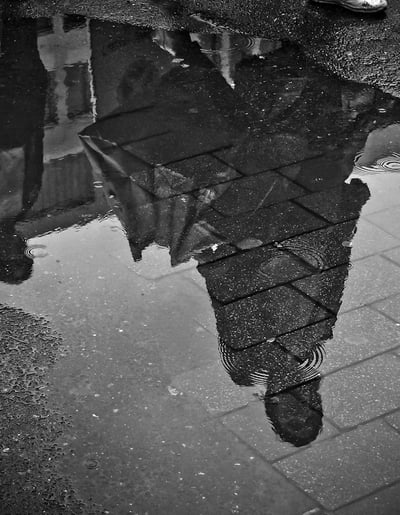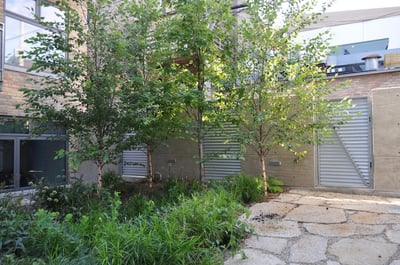If you’ve noticed a takeover of the buzz phrase “stormwater management” in the last several years, good on you. Clearly, you’ve been paying attention.
Hearing the words and understanding the meaning, however, are two entirely different concepts.
... which is why so many people roll through stop signs.
Thing is, stormwater management isn’t just a simple matter of putting water that wants to go here over there. Rather, it’s a complex process of managing the water that comes from snow, rain and ice to ensure minimum impact on ecosystems and urban infrastructures.
If you just fell asleep while reading that sentence, sorry. Also, go have some caffeine and wake the hell up. This stuff matters, and we’re about to take a bit of a dive.
So suit up.
So … What Is Stormwater, Exactly?

Let’s start by saying that in addition to boasting an adorable police force and making some surprisingly delicious BBQ, the Canadians are also on it when it comes to stormwater management.
According to the Toronto and Region Conservation Authority, stormwater is defined as “rainwater and melted snow that flows over roads, parking lots, lawn and other sites in urban areas.”
Practices to manage that water “help to minimize the impact of polluted runoff flowing into lakes and streams, and reduce the strain that stormwater places on municipal infrastructure.”
Normally, when water falls to the ground in the form of rain or comes out of the mountains in the form of snowmelt, say, vegetation and soil are there to catch it and soak it up. Plants retain water for a time before breathing it back out (transpiration), while water in soil eventually evaporates into the air (evaporation).
Together = evapotranspiration.
And you now have your vocab word for the day. *bows*
An Urban Plague: Stormwater’s Dirty Downside

In conversations and articles about stormwater management, people often frame the problem as one of stormwater itself, but that’s a bit misleading. As we said, nature actually knows how to handle stormwater pretty well (although rural stormwater management plans are also important). It’s cities that have a tougher time retaining and detaining stormwater.
Cities are coated with impermeable surfaces: cement, concrete, asphalt. These surfaces cling to the ground, rooftops and everything in between, giving water nowhere to go.
It has no choice but to collect into raging streams on the ground, where it quickly floods municipal sewer systems and causes combined sewer overflows (CSOs).
That’s when our sewer systems, meant only to handle wastewater and toilet contents, are flooded with way more liquid than they can handle. The result is that water floods back out of the sewers and into the streets, carrying all that disguising, disease-filled toilet gunk with it.
Spoiler alert: Unpleasant.
In addition to smelling not-great, overflows also pick up pollutants from city surfaces, bring disease up out of flooded sewers, and eventually spill over into waterways – contaminating and eroding them as they go.
So, you know. We should probably deal with that.
Stormwater Management Practices
How, though? Stormwater is such a big problem that many people aren’t quite sure where to start. Even those who are well-versed in management practices aren’t sure how to bring those practices to the restrictive environments of, say, rooftops with weight limits and limited media thickness, etc.
The good news? Cities are wise to the problem and many are making significant advancements. Regulations in many cities now encompass:
- Protection of natural waterways
- Control of flooding and erosion
- Detention and retention of water on new development sites
- Control of hazardous materials
- Stormwater system planning
- Blue roofs
.. and more. They do this in many ways, from layering water-retentive media on rooftops and planting an array of species to help retain (hold on to) and detain (slow down the passage of) water. Rain gardens, bioswales and other systems capture stormwater, stripping out pollutants and funneling it toward appropriate waterways.
And that’s just the beginning.
Yet we can’t simply rely on cities to take care of the job for us, now can we? Here at Ecogardens, we decided we wanted to do something about it ourselves.
What We’re Doing About Stormwater Runoff

So just what do we do here at Ecogardens to keep our cities a little less runoff-y? Well, we’re glad you asked. Quite a bit, actually. We offer:
- Green roof systems: These help to retain and detain stormwater to reduce its impact on the municipal system as well as clean stormwater before releasing it back into the environment.
- Other systems: Rain gardens, bioswales, rain barrels and detention ponds all give stormwater somewhere to go instead of the streets or sewers.
- Consulting: Building systems yourself and want some advice? Not a problem; Ecogardens is happy to sit and chat as long as you need, ensuring you get the stormwater management system you’re looking for.
- Products: Know what you want to do and how to do it, but aren’t sure about the best products for the job? Our team will help you choose from a variety of innovative, high-performing, cost-effective products that all work together, so you can use them individually, a few at a time or as an entire system.
Let Ecogardens Help You with Stormwater Services
See something you like in that list? We’d be happy to help you get what you need. Simply reach out to us here at Ecogardens, and a member of our team will speak with you about what stormwater management is, your specific needs and help you design the unique solution you’re looking for.
Because let’s be honest, we all want less poo in our lives.

